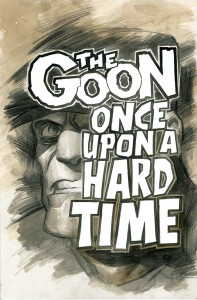 The Goon: Once Upon a Hard Time #1 (of 4) — Writer/Artist: Eric Powell
The Goon: Once Upon a Hard Time #1 (of 4) — Writer/Artist: Eric Powell
Powell toggles between two modes for this title: edgy, Harvey Kurtzman-like slapstick, and grim, dark-as-night horror. The grim, in ascendance during the last mini-series, reaches full force here, as a drunken, grieving and dangerous Goon kills a couple of people (who deserve it), rips an arm off one of his friends (who doesn’t, although he has a couple of extra to spare), and spirals down into a revengeful, suicidal haze. Depressing as hell, but very very well done, with Powell’s art and script telling an efficient, powerful story — enough to make this the best book of a better-than-average week.
 Rat God #1 (of 5) — Writer/Artist: Richard Corben
Rat God #1 (of 5) — Writer/Artist: Richard Corben
Any mini-series by Corben is a cause for celebration, and here he’s taking a break from his Edgar Allan Poe adaptations to tell a brand-new tale, which starts out in the prehistoric Northern woods, with two natives pursued by possibly-demonic entities, and then transitions to New England in the 1920s, with a number of Lovecraft undertones (the main character goes to “Miskatonic University,” and, while he seems relatively normal, says things like “By the loathsome elder gods, I think I’m lost”). All of this is rendered in Corben’s unique airbrush style, simultaneously shadowy, colorful, precise and otherworldly, a perfect match for the creeping-dread tone that he loves so much, and another bonanza for horror fans.
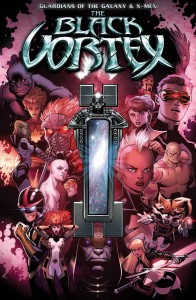 The Black Vortex: Alpha — Writer: Sam Humphries; Pencils: Ed McGuinness and Kris Anka; Inks: Anka, Mark Farmer, Jay Leisten and Mark Morales; Colors: Marte Gracia and Marcelo Maiolo
The Black Vortex: Alpha — Writer: Sam Humphries; Pencils: Ed McGuinness and Kris Anka; Inks: Anka, Mark Farmer, Jay Leisten and Mark Morales; Colors: Marte Gracia and Marcelo Maiolo
This kicks off one of those bookended crossover series (it’ll be going into a couple of months’ worth of Guardians of the Galaxy and various X-books, and then ending with an “Omega” issue in April), involving Peter Quill/Star-Lord and new girlfriend Kitty Pryde stealing the title object, an ancient mystical artifact, from Quill’s deposed-tyrant father. It’s a mirror that can bestow powers on those who gaze within it, turning them into idealized-but-darker versions of themselves, and all the bad guys want it and it’s threatening to corrupt the good guys, too. By the end of this first issue, most of the X-Men and Guardians are out in space fighting various alien entities (led by Quill’s father) for possession of it, in the kind of noisy, crowded plot that’s standard for these tales. If you’re a fan of the characters and their various series, you’ll be OK with it; if not… well, there are plenty of other good comics on the list this week, so check them out instead.
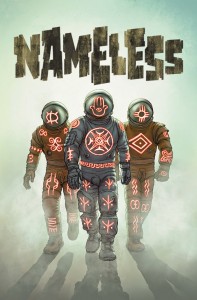 Nameless #1 — Writer: Grant Morrison; Art: Chris Burnham; Colors: Nathan Fairbairn
Nameless #1 — Writer: Grant Morrison; Art: Chris Burnham; Colors: Nathan Fairbairn
Annihilator #5 (of 6) — Writer: Grant Morrison; Art/Colors: Frazer Irving
Two by Morrison (who, with the dense, fun and attractive Multiversity Handbook from last week, is proving to be a busy creator right now); Nameless is a new title with many of his obsessions: the link between dreams and reality; the conflict between vague alien/supernatural beings that try to control us and the independent, solitary outcasts who fight them; the melding of technology and mysticism (it’s also about a race to keep a 14-mile-wide asteroid linked to the Mayan underworld from hitting the 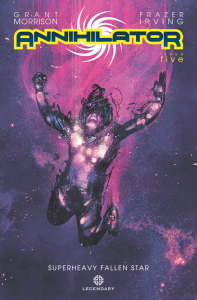 Earth and destroying everything, which elevates it from just sophomore philosophizing). Annihilator has a lot of that going on, too, but has been focusing more on its storyteller-as-creator theme; like Nameless, its actual plot is more B-movie grounded, involving an alien revolutionary/killer (depending on who’s asking), brain tumors, black holes and various other elements. Both are chunky, complicated fun, with art that’s good at combining the cosmic, the technological and the human; Irving is a little more polished and shadowy, while Burnham is a little sketchier and more indy-looking, but they’re good examples of how a decent writer can elevate the output of his visual partners, too.
Earth and destroying everything, which elevates it from just sophomore philosophizing). Annihilator has a lot of that going on, too, but has been focusing more on its storyteller-as-creator theme; like Nameless, its actual plot is more B-movie grounded, involving an alien revolutionary/killer (depending on who’s asking), brain tumors, black holes and various other elements. Both are chunky, complicated fun, with art that’s good at combining the cosmic, the technological and the human; Irving is a little more polished and shadowy, while Burnham is a little sketchier and more indy-looking, but they’re good examples of how a decent writer can elevate the output of his visual partners, too.
 Cluster #1 — Writer: Ed Brisson; Art: Damian Couceiro; Colors: Michael Garland
Cluster #1 — Writer: Ed Brisson; Art: Damian Couceiro; Colors: Michael Garland
Postal #1 — Writers: Bryan Hill and Matt Hawkins; Art: Isaac Goodhart; Colors: Betsy Gonia
Two other first issues — Cluster isn’t particularly original (it’s a space prison/Dirty Dozen/Logan’s Run/Starship Trooper mashup), but it has a brisk, breezy B-movie adventure verve that carries it along. Postal, at first, seems to be about a young small-town mailman with  Asperger’s Syndrome, a mother who’s the mayor, and a knack for detective work; then, about half-way through the first issue, it throws readers a curveball about the town itself that makes it less like a knockoff of Monk, and considerably more interesting (although not quite as grounded in reality). Its art is competent but basic, while Cluster‘s has more heft to it — although, to be fair, Couciero has quite a bit more to work with, given the book’s alien landscapes and inhabitants, and its higher action quotient.
Asperger’s Syndrome, a mother who’s the mayor, and a knack for detective work; then, about half-way through the first issue, it throws readers a curveball about the town itself that makes it less like a knockoff of Monk, and considerably more interesting (although not quite as grounded in reality). Its art is competent but basic, while Cluster‘s has more heft to it — although, to be fair, Couciero has quite a bit more to work with, given the book’s alien landscapes and inhabitants, and its higher action quotient.
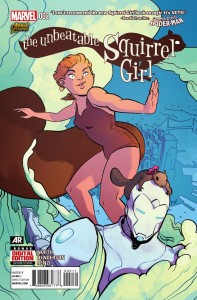 The Unbeatable Squirrel Girl #2 — Writer: Ryan North; Art: Erica Henderson; Colors: Rico Renzi
The Unbeatable Squirrel Girl #2 — Writer: Ryan North; Art: Erica Henderson; Colors: Rico Renzi
Lady Killer #2 — Story: Joelle Jones and Jamie S. Rich; Art: Joelle Jones; Colors: Laura Allred
Star Wars #2 — Writer: Jason Aaron; Art: John Cassaday; Colors: Laura Martin
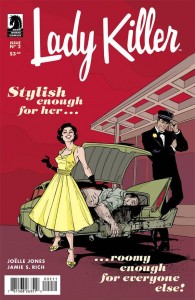 Ant-Man #2 — Writer: Nick Spencer; Art: Ramon Rosanas; Colors: Jordan Boyd
Ant-Man #2 — Writer: Nick Spencer; Art: Ramon Rosanas; Colors: Jordan Boyd
Ant-Man: Prelude #1 (of 2) — Writer: Will Corona Pilgrim; Pencils: Miguel Sepulveda; Inks: Bit; Colors: Jay David Ramos with David Curiel
A quartet of second issues (plus the extra Ant-Man offering, as Marvel starts to pump out product in 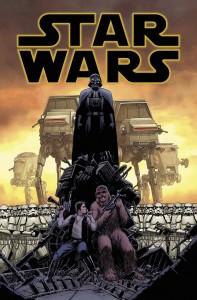 anticipation of the movie). Squirrel-Girl is clearly the best, and came close to being the pick of the week; like its first issue, it offers an all-ages story by North that manages to be brainy, cute, human and funny, with Henderson’s art matching and enhancing it every step of the way (she can do more to communicate a facial expression in a couple of seemingly-casual lines than all the crosshatching, shading and computer-generated tricks that most other lesser artists have to employ). For proof of her talents, check out that cover — and, as always, click on it and any of the others to see a larger version. Lady
anticipation of the movie). Squirrel-Girl is clearly the best, and came close to being the pick of the week; like its first issue, it offers an all-ages story by North that manages to be brainy, cute, human and funny, with Henderson’s art matching and enhancing it every step of the way (she can do more to communicate a facial expression in a couple of seemingly-casual lines than all the crosshatching, shading and computer-generated tricks that most other lesser artists have to employ). For proof of her talents, check out that cover — and, as always, click on it and any of the others to see a larger version. Lady 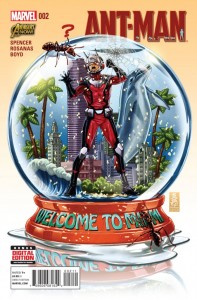 Killer‘s Jones is another up-and-coming woman artist with impressive chops; she works in a more traditional style, but with a keen eye for fashion and composition that elevates this tale of a prim ’60s housewife who’s also a contract killer into an attractive, enjoyable read. Star Wars continues Marvel/Disney’s rollout of their new version of this comics franchise, with the action taking place right after A New Hope (Vader doesn’t know who Luke is yet) and the Aaron/Cassady team offering a smooth, action-filled installment that has all the principle characters in
Killer‘s Jones is another up-and-coming woman artist with impressive chops; she works in a more traditional style, but with a keen eye for fashion and composition that elevates this tale of a prim ’60s housewife who’s also a contract killer into an attractive, enjoyable read. Star Wars continues Marvel/Disney’s rollout of their new version of this comics franchise, with the action taking place right after A New Hope (Vader doesn’t know who Luke is yet) and the Aaron/Cassady team offering a smooth, action-filled installment that has all the principle characters in  familiar form. Ant-Man sees its title hero setting up shop in Miami as a security consultant; its tone isn’t quite as tongue-in-cheek funny as Squirrel Girl, but has a good combination of light touch seasoned with occasional drama that’s reminiscent of, say, She-Hulk, and, given the upcoming movie, should keep it around for a while. The movie’s the reason for the Ant-Man Prequel, too, which sees a younger Hank Pym working as a scientist for S.H.I.E.L.D. and getting talked by Peggy Carter (and Howard Stark) into trying out the prototype of his suit and Pym-particle powers in a spy mission to still-Communist East Berlin; it has a solid, traditional plot-and-art combination that, for some reason, reminds me of old David Michelenie/Bob Layton Iron Man comics.
familiar form. Ant-Man sees its title hero setting up shop in Miami as a security consultant; its tone isn’t quite as tongue-in-cheek funny as Squirrel Girl, but has a good combination of light touch seasoned with occasional drama that’s reminiscent of, say, She-Hulk, and, given the upcoming movie, should keep it around for a while. The movie’s the reason for the Ant-Man Prequel, too, which sees a younger Hank Pym working as a scientist for S.H.I.E.L.D. and getting talked by Peggy Carter (and Howard Stark) into trying out the prototype of his suit and Pym-particle powers in a spy mission to still-Communist East Berlin; it has a solid, traditional plot-and-art combination that, for some reason, reminds me of old David Michelenie/Bob Layton Iron Man comics.
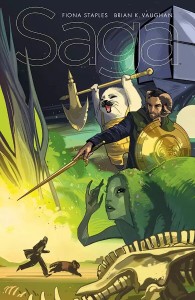 Saga #25 — Writer: Brian K. Vaughan; Art/Colors: Fiona Staples
Saga #25 — Writer: Brian K. Vaughan; Art/Colors: Fiona Staples
Wytches #4 — Writer: Scott Snyder; Art: Jock; Colors: Matt Hollingsworth
Velvet #9 — Writer: Ed Brubaker; Art: Steve Epting; Colors: Elizabeth Breitweiser
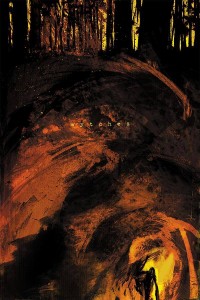 Stray Bullets: Sunshine and Roses #1 — Writer/Artist: David Lapham
Stray Bullets: Sunshine and Roses #1 — Writer/Artist: David Lapham
A bunch of Image comics, as they continue to cement their status as the third major publisher, thanks to creator-friendly deals that attract top talent. Saga is one of their best-selling titles (only the pop-cultural phenomenon that is Walking Dead keeps it from being at the top), and deservedly so, as a look at Staples’s excellent, evocative art and Vaughan’s sprawling-but-character-rich story will attest. This begins the first 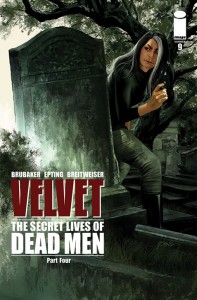 chapter of Volume Five, so is a good place to check in with the scattered cast, with Alana, her daughter and her mother-in-law kidnapped, Marco and an enemy searching for them, and most of the rest on a remote planet trying to find a cure for The Will (Saga always manages at least one WTF? moment per book, and this one’s, involving a female dragon on that planet, echoes a much-earler scene involving a naked male giant). Wytches continues its claustrophobic, paranoid take on its mostly-unseen horrors in the woods, with a number of secrets about them revealed in this issue, and the tension continuing
chapter of Volume Five, so is a good place to check in with the scattered cast, with Alana, her daughter and her mother-in-law kidnapped, Marco and an enemy searching for them, and most of the rest on a remote planet trying to find a cure for The Will (Saga always manages at least one WTF? moment per book, and this one’s, involving a female dragon on that planet, echoes a much-earler scene involving a naked male giant). Wytches continues its claustrophobic, paranoid take on its mostly-unseen horrors in the woods, with a number of secrets about them revealed in this issue, and the tension continuing 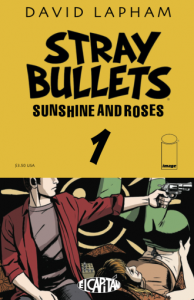 to mount as the main character searches for his lost-to-them daughter. Velvet is still a cool, stylish ’60s-set spy story, whose plot gets twistier every issue, as its tough, plucky heroine tries to think and fight her way out of a world-spanning frameup, while Stray Bullets mines a similar suspense vein, but grittier, on a more local scale and without the high-concept spy parts. Lapham’s apparently decided to make each arc of this revival its own mini-series, and then collect them into trades, since there’s no other reason for starting this over as a first issue — it’s the same high-quality, superbly-constructed action as ever, its noir elements and colorful characters working at cross-purposes reminiscent of an early Coen brothers movie.
to mount as the main character searches for his lost-to-them daughter. Velvet is still a cool, stylish ’60s-set spy story, whose plot gets twistier every issue, as its tough, plucky heroine tries to think and fight her way out of a world-spanning frameup, while Stray Bullets mines a similar suspense vein, but grittier, on a more local scale and without the high-concept spy parts. Lapham’s apparently decided to make each arc of this revival its own mini-series, and then collect them into trades, since there’s no other reason for starting this over as a first issue — it’s the same high-quality, superbly-constructed action as ever, its noir elements and colorful characters working at cross-purposes reminiscent of an early Coen brothers movie.
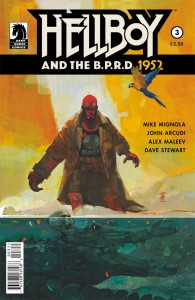 Hellboy and the B.P.R.D.: 1952 #3 (of 5) — Story: Mike Mignola and John Arcudi; Art: Alex Maleev; Colors: Dave Stewart
Hellboy and the B.P.R.D.: 1952 #3 (of 5) — Story: Mike Mignola and John Arcudi; Art: Alex Maleev; Colors: Dave Stewart
This story, about Hellboy’s first mission with his co-stars, and set in South America during the title year, features turncoats, brain-altered monkeys, ancient evils, Mignola and Arcudi’s typically-smart, pulpy horror, and Maleev’s always-interesting art (he and Mignola should have a shadow-filled ink-off sometime…).
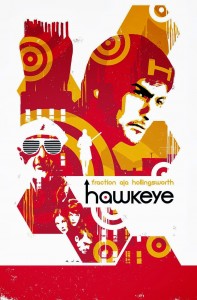 Hawkeye #21 — Writer: Matt Fraction; Art: David Aja; Colors: Matt Hollingsworth
Hawkeye #21 — Writer: Matt Fraction; Art: David Aja; Colors: Matt Hollingsworth
Penultimate issue, and it ends on a cliffhanger/apparent death, plus the return of an important character. It’s really been too long between issues to remember all of the story; it’s hard to see how this all gets resolved satisfactorily in one more issue, but I’m willing to give this team the benefit of the doubt. I think we’re all going to have to wait six months or a year after this is all over, and then just read all 22 issues in the trades to really see how it holds up — but I’m looking forward to it, and I bet the answer will be “really well.”
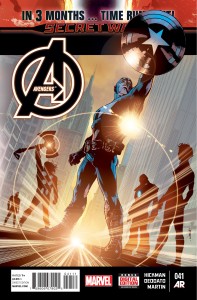 Avengers #41 — Writer: Jonathan Hickman; Art: Mike Deodato; Colors: Frank Martin
Avengers #41 — Writer: Jonathan Hickman; Art: Mike Deodato; Colors: Frank Martin
With the universal-collision “incursions” having reduced millions of alternate earths to just a few dozen, it’s inevitable that the Ultimate universe should come into the mix (offering an out to the Cadre and a certain Atlantian prince who were seemingly destroyed over in the last New Avengers), as Hickman’s two-years’-long plot starts to round into its final months and the way is paved for this summer’s Secret Wars. Comics can do this kind of serial buildup, and ebb and flow and eventual payoff, better than almost any other medium, and for fans who’ve been following this from the beginning, through more than two years of twin titles, an Infinity mini-series and a couple of other books, it’s starting to offer a very satisfactory return on their investment.
 The United States of Murder, Inc. #6 — Writer: Brian Michael Bendis; Art: Michael Avon Oeming; Colors: Taki Soma
The United States of Murder, Inc. #6 — Writer: Brian Michael Bendis; Art: Michael Avon Oeming; Colors: Taki Soma
Bendis and Oeming’s alternate-timeline story where, somewhere in the ’60s, the Mafia staged a political takeover of most of the East Coast (and Las Vegas), and are now in an uneasy standoff with the US Government. It’s worth reading to see the Powers team’s lively cast of G-Men, gangsters and tough guys and gals, with their snappy patter and quick, often-murderous action.
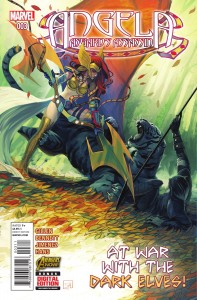 Angela: Asgard’s Assassin #3 — Writer: Kieron Gillen; Pencils: Phil Jimenez; Inks: Le Beau Underwood
Angela: Asgard’s Assassin #3 — Writer: Kieron Gillen; Pencils: Phil Jimenez; Inks: Le Beau Underwood
Angela and her companion Sera deal with Dark Elves (and the Asgardians who are pursuing them because they have Odin’s newborn daughter), and we get the origin of Sera, while Thor and Loki call on Hela to aid their hunt, and she brings in some serious firepower. This hasn’t been taking off for me yet, the way some of Gillen’s other books with these characters — especially Journey Into Mystery — have, but I’m willing to give it a couple more issues to find its tone.
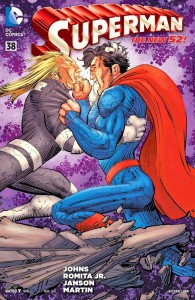 Superman #38 — Writer: Geoff Johns; Pencils: John Romita Jr.; Inks: Klaus Janson; Colors: Mark Martin
Superman #38 — Writer: Geoff Johns; Pencils: John Romita Jr.; Inks: Klaus Janson; Colors: Mark Martin
The conclusion to the Ulysses story, featuring a big ol’ fight between him and the title character (nicely and pyrotechnically drawn by Romita Jr., with a big assist from Martin’s coloring and Janson’s inking), the revelation of a “new” power (one I could swear Superman’s used once or twice before), a small-but-significant costume change, and a surprising, and quietly earth-shaking, move by Clark Kent at the end; this is one of the few mainstream DC books, other than Batman, that are just too dependably entertaining to pass up.
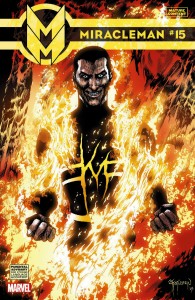 Miracleman #15 — Writer: Alan Moore; Art: John Totleben
Miracleman #15 — Writer: Alan Moore; Art: John Totleben
This reprints the most-talked-about book of Moore’s original run: with his old Swanp Thing partner Totleben on art, he offers a horrific view of the collateral damage to humans when gods battle, especially when one of them’s a murderous, unstoppable sociopath and the battle takes place in the middle of London. The scenes of a ruined city, with its eerie, sculpted piles of bodies and few dazed and wounded survivors, have even more resonance in our post-9/11 world of terrorism than they did when they were first published in 1988, and the conclusion retains its quiet devastation. Since this has only been reprinted once, in the long-out-of-print Miracleman trade collection, and the original comic goes for over $100, it’s more than worth a look.



